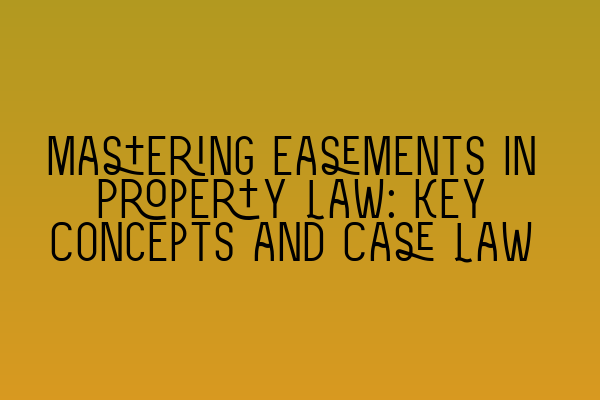Mastering Easements in Property Law: Key Concepts and Case Law
In the vast field of property law, easements play a crucial role in determining the rights and obligations between different parties with regards to land. Understanding easements is essential for property lawyers as they navigate through complex transactions and disputes. In this blog post, we will delve into the key concepts and case law surrounding easements to help you master this important area of property law.
What is an Easement?
An easement is a legal right that one party has over another’s land, allowing them to use or restrict the use of that land in a specific way. It creates a non-possessory interest in land and is typically granted for the benefit of another land or property. The party benefiting from the easement is known as the dominant tenement, while the party burdened by the easement is the servient tenement.
Easements can take various forms, including rights of way, rights to light, rights to support, and rights of drainage. Each easement serves a specific purpose and is created differently, depending on the circumstances.
Creation of Easements
Easements can be created in several ways:
- Express Grant: An easement can be expressly granted by the owner of the servient tenement to the owner of the dominant tenement. This is typically done through a formal written agreement or deed.
- Implied Grant: An easement can be impliedly granted when certain conditions are met. For example, if two parcels of land were once under common ownership and one parcel was divided and sold, an easement may be implied for the benefit of the divided parcel.
- Prescription: An easement can be acquired by prescription if the dominant tenement has openly and without interruption used the servient tenement for a specified period of time.The requirements for acquiring an easement by prescription vary depending on the jurisdiction.
In all cases, it is crucial to ensure that the easement is properly documented, registered, and enforceable to avoid disputes in the future.
Case Law on Easements
Over the years, several key cases have shaped the understanding and application of easements in property law. Familiarizing yourself with these cases can improve your understanding and enhance your ability to handle easement-related matters effectively. Here are a few notable examples:
- Wheeldon v Burrows (1879): This case established the doctrine of implied grant, which allows for the creation of easements when certain conditions are met. The court held that when land is divided, any reasonable and necessary easements over the divided land are impliedly granted.
- Woolworths Ltd v W H Smith (Joinery) Ltd (1982): In this case, the court discussed the principle of abandonment of easements. It clarified that an easement can be abandoned if the dominant owner demonstrates a clear intention to relinquish the right and the servient owner consents to the abandonment.
- London & Blenheim Estates Ltd v Ladbroke Retail Parks Ltd (1992): This case explored the concept of a right to light easement. It highlighted the importance of considering the effect of a proposed development on the access of light to neighboring properties and the potential liability of the developer.
These cases, along with many others, shape the legal landscape surrounding easements and provide guidance for resolving disputes and interpreting the law.
Conclusion
Easements are a vital aspect of property law, providing rights and restrictions that help ensure the smooth functioning of land ownership and use. Understanding the key concepts and case law surrounding easements can greatly benefit property lawyers in their daily practice. By mastering easements, you can navigate complex transactions, draft effective agreements, and confidently handle easement-related disputes.
If you are preparing for the SQE exams, don’t forget to check out our related articles:
- SQE 1 Practice Exam Questions
- SQE 1 Practice Mocks FLK1 FLK2
- SQE 2 Preparation Courses
- SQE 1 Preparation Courses
- SRA SQE Exam Dates
At SQE Property Law & Land Law, we offer comprehensive preparation courses for the SQE exams, designed to help you succeed in your legal career. Feel free to contact us for more information and guidance on your journey to becoming a qualified solicitor.
